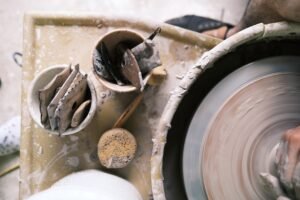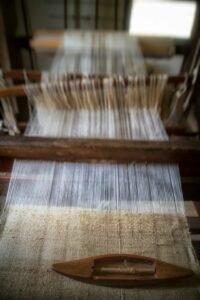Comprehensive Guide of Felting
Overview
Felting is a unique and tactile craft that involves matting, condensing, and pressing fibers together to create a dense fabric. This hobby can be practiced using various materials, with wool being the most common due to its natural properties that allow for easy felting. Felting can be done through two primary methods: wet felting, which uses water and soap to agitate the fibers, and needle felting, which employs a barbed needle to interlock the fibers without moisture. This versatile craft allows individuals to create a wide range of items, including clothing, accessories, home decor, and artistic sculptures. Felting not only fosters creativity but also provides a satisfying hands-on experience, making it a popular choice for crafters of all skill levels.
History
The history of felting dates back thousands of years, with evidence suggesting that it was practiced by ancient civilizations such as the Egyptians and the Mongols. The earliest known felt artifacts, including clothing and blankets, have been discovered in burial sites, indicating its significance in daily life and culture. Felting techniques were traditionally passed down through generations, often associated with nomadic lifestyles where portable and durable materials were essential. In the 20th century, felting experienced a revival as a craft, with artists and crafters exploring new techniques and applications. Today, felting is celebrated not only as a functional craft but also as an art form, with contemporary artists pushing the boundaries of what can be created with felt.
Popularity and Demographics
Felting has gained popularity as a hobby among diverse demographics, appealing to both young and older crafters. Its accessibility and the relatively low cost of materials make it an attractive option for beginners. According to craft industry reports, felting has seen a surge in interest, particularly in the United States and Europe, where workshops and online classes have become widely available. Social media platforms, especially Pinterest and Instagram, have played a significant role in promoting felting, allowing enthusiasts to share their creations and connect with others in the crafting community. Additionally, felting is often incorporated into educational settings, where children and adults alike can explore their creativity through hands-on projects, further contributing to its growing popularity.
Sponsored Hobbyists and Vendors
Become a Sponsor!
Affiliate Disclaimer: Throughout some sections below, Hobby Spotlight may suggest some tools, equipment or material using affiliate links. By purchasing any of those items, Hobby Spotlight may earn a small commission. This helps fund our website, content and services without directly charging our users.
Getting Started
Felting Tools and Equipment:
Beginner
- Felting Needle: Basic felting needle for shaping wool.
- Wool Roving: Soft, unspun wool for felting projects.
- Felting Mat: Protective mat for needle felting.
- Scissors: Sharp scissors for cutting wool and fabric.
- Felting Foam Pad: Foam pad to support felting work.
Intermediate
- Multi-Needle Felting Tool: Tool for faster felting with multiple needles.
- Wool Batting: Pre-carded wool for larger felting projects.
- Felting Loom: Loom for creating flat felted pieces.
- Felting Needle Holder: Holder for better grip and control of felting needles.
- Felting Patterns: Templates and patterns for advanced felting designs.
Basic Requirements and Initial Setup:
- Felting Wool: High-quality wool, such as merino or corriedale, is essential for successful felting. The wool should be clean, carded, and ready for use.
- Felting Needles: These specialized needles have barbs that help interlock the wool fibers. A variety of needle sizes is useful for different felting techniques.
- Felting Surface: A sturdy surface, like a foam pad or a wool mat, is necessary to protect your work area and provide a base for needle felting.
Fundamental Skills to Learn:
- Needle Felting Technique: Mastering the technique of repeatedly poking the wool with a felting needle to interlock fibers and create shapes.
- Wool Preparation: Learning how to card and prepare wool for felting, ensuring it is clean and free of debris.
- Color Blending: Understanding how to blend different colors of wool to create unique shades and effects in your projects.
- Shaping and Sculpting: Developing skills to shape and sculpt wool into desired forms, whether flat or three-dimensional.
- Finishing Techniques: Learning how to finish your felted items, including trimming, adding embellishments, and securing loose fibers.
Sub-Hobby/Common Activities:
- Needle Felting: Creating detailed sculptures and designs by repeatedly poking wool with a felting needle.
- Wet Felting: Using water, soap, and agitation to create felt fabric from loose wool fibers.
- Felting Accessories: Making items like bags, hats, and scarves using felting techniques.
- Felting for Home Decor: Crafting decorative items such as wall hangings, coasters, and ornaments.
- Felting Workshops: Participating in classes or workshops to learn new techniques and meet fellow felting enthusiasts.
Terminology:
- Felting: The process of matting, condensing, and pressing wool fibers together to create a non-woven fabric.
- Needle Felting: A technique that uses barbed needles to interlock wool fibers without the use of water.
- Wet Felting: A method that involves using water and soap to agitate wool fibers, causing them to bond together.
- Carding: The process of detangling and separating wool fibers to prepare them for felting.
- Merino Wool: A type of wool known for its softness and fine texture, ideal for felting projects.
- Core Wool: Coarser wool used as a base for needle felting projects, providing structure.
- Barbed Needle: A specialized needle used in needle felting that has small barbs to catch and interlock wool fibers.
- Resist: A technique used in wet felting to create shapes or patterns by preventing wool from felting in certain areas.
- Embroidery: Adding decorative stitching to felted items for embellishment.
- Finishing: The final steps taken to complete a felted project, including trimming and securing loose fibers.
Advanced Topics and Specializations
Advanced Tools and Equipment:
- Merino Wool Roving: High-quality, soft merino wool roving ideal for creating intricate felted designs.
- Felting Needle Set: A set of various gauge felting needles for detailed and precise felting work.
- Felting Foam Pad: A durable foam pad that provides a stable surface for needle felting projects.
- Wet Felting Kit: Comprehensive kit including wool, soap, and mesh for creating felted items using the wet felting technique.
- Felting Machine: An electric felting machine that speeds up the felting process for larger projects.
Advanced Projects and Achievements:
- Life-Size Animal Sculptures: Creating realistic, life-sized representations of animals using wool felting techniques, showcasing intricate details and textures.
- Wearable Art: Designing and crafting unique felted garments and accessories, such as hats, scarves, and jewelry, that blend fashion with artistic expression.
- Felted Home Decor: Producing decorative items like wall hangings, rugs, and cushions that incorporate vibrant colors and patterns, enhancing interior spaces.
Advanced Techniques and Methods:
- Wet Felting: Utilizing water, soap, and agitation to mat wool fibers together, creating a dense and durable fabric suitable for various projects.
- Needle Felting: Employing barbed needles to interlock wool fibers, allowing for detailed sculpting and the creation of intricate designs and figures.
- Resist Felting: Using materials like plastic or wax to create patterns and shapes in felt by preventing the fibers from matting in certain areas.
Specializations and Niche Areas:
- Eco-Friendly Felting: Focusing on sustainable practices by using natural, organic wool and dyes to create environmentally conscious products.
- Felted Toys and Dolls: Crafting soft, whimsical toys and dolls that appeal to children and collectors alike, often featuring unique characters and designs.
- Felted Pet Accessories: Designing custom pet beds, toys, and clothing that combine functionality with artistic flair for pet lovers.
- Felted Art Installations: Creating large-scale art pieces for exhibitions that explore themes through the medium of felt, often incorporating mixed media.
- Felted Jewelry: Making lightweight, colorful jewelry pieces that showcase the versatility of felt in fashion accessories.
Future Trends and Innovations:
- Increased interest in sustainable and ethically sourced materials in felting projects.
- Growth of online communities and platforms for sharing techniques, patterns, and tutorials.
- Integration of mixed media in felting, combining wool with other materials like leather, beads, and metal.
- Emergence of workshops and classes focusing on advanced felting techniques and artistic expression.
- Expansion of felted products into mainstream fashion and home decor markets.
Technology Integrations:
- Online Tutorials and Workshops: Access to a wealth of video tutorials and live classes that teach various felting techniques and projects.
- Social Media Platforms: Utilizing platforms like Instagram and Pinterest to showcase felting work, share inspiration, and connect with other felters.
- 3D Printing for Felting Tools: Development of custom felting tools and accessories through 3D printing technology to enhance the crafting experience.
- Virtual Reality Experiences: Exploring felting techniques in immersive environments, allowing users to practice skills in a virtual setting.
- Mobile Apps for Pattern Sharing: Apps that allow felters to share patterns, tips, and project ideas, fostering a collaborative community.
Further Learning and Resources
Books:
- Merino Wool Roving: High-quality, soft merino wool roving ideal for creating intricate felted designs.
- Felting Needle Set: A set of various gauge felting needles for detailed and precise felting work.
- Felting Foam Pad: A durable foam pad that provides a stable surface for needle felting projects.
- Wet Felting Kit: Comprehensive kit including wool, soap, and mesh for creating felted items using the wet felting technique.
- Felting Machine: An electric felting machine that speeds up the felting process for larger projects.
Websites:
- Wool Felt Company, https://www.woolfeltcompany.com – A comprehensive resource for felting supplies, kits, and tutorials for all skill levels.
- FeltMagnet, https://feltmagnet.com – A community-driven site featuring articles, projects, and tips on various felting techniques.
- National Felting Association, https://www.nationalfeltingassociation.org – Offers resources, events, and a directory of felting artists and workshops.
- Felted Bliss, https://feltedbliss.com – A blog dedicated to felting projects, tutorials, and inspiration for crafters.
- Craftsy, https://www.craftsy.com’ – Provides a variety of felting classes and resources for beginners and advanced felters alike.
Courses:
- Beginner’s Guide to Needle Felting, https://www.udemy.com/course/beginners-guide-to-needle-felting – An introductory course covering the basics of needle felting techniques and projects.
- Wet Felting Techniques, https://www.skillshare.com/classes/Wet-Felting-Techniques/123456 – Learn the art of wet felting with step-by-step instructions for various projects.
- Advanced Needle Felting, https://www.craftsy.com/class/advanced-needle-felting – A course designed for experienced felters looking to refine their skills and explore complex techniques.
- Felted Animals Workshop, https://www.feltmagnet.com/felted-animals-workshop – Focuses on creating adorable felted animal figures using various felting methods.
- Felted Home Decor, https://www.woolfeltcompany.com/courses/felted-home-decor – A course that teaches how to create beautiful felted items for home decoration.
Content Creators and Community
Content Creators:
- The Wooly Wonders (YouTube): Specializes in needle felting tutorials, showcasing a variety of projects from beginner to advanced levels, with a focus on creating adorable felted animals and decorations.
- Felted Creations (Instagram): A talented artist sharing stunning felted artwork and step-by-step processes, inspiring followers with unique designs and techniques.
- Felted Artistry (Etsy): An online shop featuring handcrafted felted items, along with tutorials and tips for aspiring felters looking to enhance their skills.
Online Forums and Social Media Groups:
- Reddit – /r/Felting: A community for sharing projects, techniques, and advice related to felting.
- Facebook Felting Groups: Various groups where enthusiasts share their creations, ask questions, and provide support to one another.
- Instagram Hashtags (#felting, #needlefelting): Follow these hashtags to discover new projects, tutorials, and inspiration from fellow felters.
- Pinterest Boards: Explore a wealth of felting ideas, patterns, and tutorials curated by passionate crafters.
Local Clubs and Organizations:
- Felting Workshops: Many craft stores and community centers offer local felting classes where enthusiasts can learn and share techniques.
- Artisan Craft Guilds: Local guilds often host felting events, competitions, and exhibitions to promote the craft.
- Meetup Groups: Platforms like Meetup.com can help you find local felting clubs and gatherings for sharing ideas and projects.
- Fiber Arts Festivals: Events that celebrate various fiber arts, including felting, with workshops and demonstrations.
Events, Meetups, and Conventions:
- International Feltmakers Association Events: Gatherings that focus on felting techniques, showcasing artists and their work.
- Local Craft Fairs: Many craft fairs feature felting demonstrations and opportunities to connect with other felters.
- Fiber Festivals: Events dedicated to all fiber arts, including felting, with workshops, vendors, and networking opportunities.
- Felting Retreats: Organized retreats where felters can immerse themselves in the craft, learn new skills, and connect with others.
Associated Hobbies
- Knitting: Knitting is a popular craft that often complements felting. Many knitters create items that can be felted, such as bags or garments, enhancing their texture and durability through the felting process.
- Crocheting: Similar to knitting, crocheting can also lead to felted projects. Crocheters may create intricate designs that can be felted to achieve a unique look and feel.
- Sewing: Sewing is a versatile hobby that pairs well with felting. Crafters can sew felted pieces together to create bags, toys, or home decor items, allowing for endless creativity.
- Embroidery: Adding embroidery to felted items can enhance their visual appeal. Many felters enjoy embellishing their creations with intricate stitching, making each piece unique.
- Quilting: Quilting can incorporate felted materials, providing texture and warmth to quilts. Felters may use their skills to create felted squares or patches for quilting projects.
- Weaving: Weaving can be combined with felting techniques to create unique textiles. Some crafters weave their own fabric and then felt it to achieve a different texture and appearance.
- Spinning: Spinning yarn from wool or other fibers is a natural companion to felting. Many felters enjoy spinning their own yarn, which can then be used in their felted projects.
- Crafting with Children: Felting is a family-friendly hobby that can be enjoyed with children. Many parents introduce felting to their kids as a fun and creative way to explore crafting together.
Cost and Budgeting
Initial Investment and Ongoing Costs:
- Initial Investment: To start felting, you will need basic supplies such as wool roving, felting needles, and a foam pad. The initial investment can range from $30 to $100, depending on the quality and quantity of materials purchased. If you opt for a felting machine, the cost can increase to $200 or more.
- Ongoing Costs: Ongoing costs primarily include purchasing additional wool roving, which can range from $5 to $20 per ounce, depending on the type and quality. You may also need to replace felting needles, which can cost around $1 to $3 each, and foam pads, which may wear out over time.
Budget-Friendly Options:
- Starter Kits: Many craft stores offer felting starter kits that include all the essential tools and materials at a discounted price, making it easier for beginners to get started.
- Bulk Purchases: Buying wool roving in bulk can significantly reduce costs. Look for suppliers that offer discounts for larger quantities.
- DIY Tools: Consider making your own felting tools, such as using a sponge or a piece of foam instead of purchasing a specialized felting pad, to save money.
Where to Buy:
- Local Craft Stores: Stores like Michaels or Joann Fabrics often carry felting supplies and can provide helpful advice for beginners.
- Online Retailers: Websites like Amazon, Etsy, and specialty craft sites like The Woolery offer a wide range of felting materials and tools, often with customer reviews to help guide your choices.
- Wool Farms and Co-ops: Purchasing directly from wool farms or co-ops can provide high-quality materials at competitive prices, and you may also find unique colors and blends.
Money Making
How to Turn the Hobby into a Profession or Side Hustle:
- Felting Artist: Create unique felted artworks, such as sculptures, wall hangings, or decorative pieces. You can sell your creations at local art fairs, galleries, or online platforms like Etsy. Building a personal brand around your artwork can attract collectors and art enthusiasts.
- Felting Workshops: Share your passion for felting by hosting workshops in your community or online. Teach others the techniques of wet felting or needle felting, providing them with the materials and guidance they need to create their own projects. This can be a rewarding way to connect with others while earning income.
- Custom Felted Products: Offer custom felting services to create personalized items such as felted toys, home decor, or accessories. By marketing your ability to create bespoke pieces, you can attract clients looking for unique gifts or home accents that reflect their personal style.
- Felting Supplies Retailer: Start a business selling felting supplies, including wool roving, felting needles, and kits for beginners. You can set up an online store or partner with local craft shops to provide essential materials for fellow felters, tapping into the growing crafting community.
- Felting Content Creator: Utilize social media platforms like Instagram, YouTube, or TikTok to showcase your felting projects and techniques. By creating engaging content, you can build a following and monetize your channel through sponsorships, affiliate marketing, or selling your own instructional materials.
Benefits and Enjoyment
Physical, Mental, and Social Benefits:
- Physical Activity: Felting involves the manipulation of wool fibers, which can enhance fine motor skills and hand-eye coordination. The process of rolling, rubbing, and shaping the wool can also provide a gentle workout for the hands and arms.
- Mental Relaxation: Engaging in felting can be a meditative experience, allowing individuals to focus on the tactile sensations and creative process. This can lead to reduced stress and anxiety, promoting a sense of calm and mindfulness.
- Social Connection: Felting can be a communal activity, often enjoyed in workshops or classes. This fosters connections with others who share similar interests, creating a supportive community where individuals can share techniques, ideas, and inspiration.
Success Stories and Inspirational Examples:
- Felted Friends: A group of artisans who started a small business creating unique felted toys and accessories. Their passion for felting turned into a successful venture, showcasing their work at local craft fairs and online platforms, inspiring others to explore their creativity.
- Felt United: An international community of felt artists who collaborate on projects and exhibitions. Their collective efforts have brought attention to the art of felting, encouraging more people to take up the craft and appreciate its artistic value.
- Sarah’s Felted Creations: An individual who began felting as a hobby and eventually opened an online store. By sharing her journey and techniques through social media, she has inspired countless others to start felting, demonstrating how a passion can lead to a thriving business.
Ways to Enjoy and Grow in the Hobby:
- Experiment with Techniques: Explore different felting methods, such as wet felting, needle felting, or nuno felting. Trying out various techniques will enhance your skills and keep the hobby fresh and exciting.
- Join a Felting Group: Connecting with local or online felting communities can provide support, inspiration, and opportunities to learn from experienced felters. Participating in group projects or challenges can also enhance your enjoyment of the craft.
- Attend Workshops and Classes: Enroll in felting workshops to learn new skills and techniques from experts. These classes can provide valuable hands-on experience and help you expand your creative horizons.
Challenges and Solutions
Common Challenges Faced by Hobbyists:
- Learning Curve: Felting can be challenging for beginners, as it requires a certain level of skill and technique to create desired shapes and textures. Many new hobbyists may feel overwhelmed by the various methods and tools available.
- Material Costs: High-quality wool and felting supplies can be expensive, which may deter some individuals from fully engaging in the hobby. It’s essential to find a balance between quality and budget.
- Time Commitment: Creating felted items can be time-consuming, especially for intricate projects. Hobbyists may struggle to find the time to dedicate to felting amidst their busy schedules.
Tips for Overcoming These Challenges:
- Start Simple: Begin with basic projects that require minimal skills and materials. As you gain confidence, gradually move on to more complex designs.
- Buy in Bulk: Consider purchasing wool and supplies in bulk or during sales to reduce costs. Joining a local felting group can also provide access to shared resources.
- Set Aside Dedicated Time: Schedule specific times for felting in your week. Treat these sessions as important appointments to ensure you make progress on your projects.
Safety Considerations and Best Practices:
- Always use sharp tools, such as felting needles, with caution to avoid injury. Keep your fingers away from the needle’s path while working.
- Work in a well-ventilated area, especially when using any adhesives or dyes, to minimize exposure to fumes.
- Keep your workspace organized to prevent accidents and ensure that all tools and materials are stored safely when not in use.
- Be mindful of allergies, particularly to wool or other fibers, and take necessary precautions if you have sensitivities.
- Practice good hygiene by washing your hands after handling materials, especially if you are working with dyes or other chemicals.
Conclusion and Encouragement
Recap of Key Points:
- Felting is a unique craft that involves matting, condensing, and pressing fibers together to create a dense fabric, allowing for endless creative possibilities.
- There are two main types of felting: wet felting, which uses water and soap to agitate the fibers, and needle felting, which uses a barbed needle to interlock the fibers without moisture.
- This hobby is accessible to all skill levels, from beginners to advanced crafters, and can be used to create a variety of items, including clothing, accessories, and home decor.
- Felting encourages mindfulness and relaxation, as the repetitive motions involved can be meditative and provide a sense of accomplishment.
- With a relatively low startup cost, felting can be an affordable hobby that allows for experimentation with different techniques and materials.
Encouragement to Start and Enjoy the Hobby:
- Felting is a fantastic way to express your creativity. Whether you want to make gifts, home decor, or personal items, the possibilities are endless, and you can tailor your projects to your interests.
- This hobby can be enjoyed alone or in groups, making it a great social activity. Join a local crafting group or take a class to meet fellow felters and share ideas and techniques.
- Starting with felting is easy and requires minimal materials. You can begin with just a few basic supplies, such as wool roving and a felting needle, making it an accessible hobby for everyone.
Final Tips and Motivational Thoughts:
- Don’t be afraid to experiment with different fibers and techniques. Felting is all about exploration, and mistakes can lead to unexpected and beautiful results.
- Stay patient and enjoy the process. Felting can take time to master, but each project is an opportunity to learn and grow your skills.
- Share your creations with others and seek feedback. Engaging with the crafting community can inspire you and help you improve your techniques while building connections with fellow enthusiasts.

















